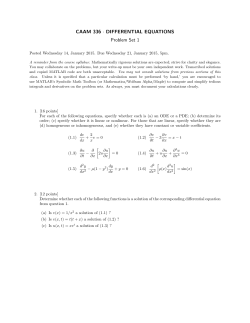
MatlabImageProcessing
Advanced MATLAB
046746
Topics
• Data Types
• Image Representation
• Image/Video I/O
• Matrix access
• Image Manipulation
• MEX - MATLAB Executable
• Data Visualization
• General Tips
• Tricks
Data Types
• Relevant data types
•
•
•
•
•
double – default in most cases (usually 64 bit)
single – when you want to save memory (usually 32 bit)
uint8 – [0 255] – native for images
uint16 – [0 65,535]
Logical – [0 1] – native for masks
• Simple casting: double(), uint8().
• Useful when displaying images with a dynamic range
not corresponding to its actual type.
• Conversion (of images):
im2double(),im2uint8(),lab2double(),lab2uint8()
• rgb2ind(),ind2rgb(),makecform()
Common problem
I = imread('world.jpg');
I2 = I-1.4;
diffI = I-I2;
fprintf('Max difference between images: %d\n',max(diffI(:)));
Max difference between images: 1
fprintf('Max difference between images:
%2.1f\n',max(diffI(:)));
Max difference between images: 1.4
A much better practice is:
display([ 'Max difference between images: ' num2str( max(diffI(:)) ) ]);
Max difference between images: 1.4
Image Representation
2D Matrix
• Intensity: Each pixel value in the dynamic range [minP, maxP].
• Can represent a grayscale image, results of a 2d function, etc.
• Useful commands: imagesc(), axis, colormap().
• Binary: a.k.a masks.
• Can represent absolute ground truth, etc.
• Useful commands:
bwlabel(),bwmorph(),bwdist(),im2bw(),bwperim().
Image Representation
2D Matrix
• Indexed: Each pixel value in the range [minP, maxP].
• Can represent segmentation.
• Useful commands: regionprops(),label2rgb()
Image Representation
3D Matrix
• True Color: Three 2D matrices stacked. Each represents a color
component. (e.g. RGB)
• Can represent an RGB color image, LAB image, etc.
• Useful commands: imshow(),rgb2gray(),rgb2ind().
Image/Video I/O
Useful Commands
•
•
•
•
•
•
•
•
•
imread() – read image
imwrite() – write image
im2frame() – convert image to movie frame
movie2avi() – write avi file
aviread() – read avi file
mmreader()/VideoReader() – read video (better)
VideoWriter() – create video file (2011b+)
movie() – show movie
implay() – show video interactively
Matrix access
Useful Commands:
• Ind = sub2ind(matrixSize, rowSub, colSub) convert subscript to
index.
• [I,J] = ind2sub(siz,IND) – convert index to subscipt.
• meshgrid() – generate X,Y grids.
• F = scatteredInterpolant(x,y,v) - creates an interpolant that fits
a surface of the form v = F(x,y). (replaced TriScatteredInterp)
Image Manipulation
Useful Commands:
•
•
•
•
•
•
•
•
•
•
•
imcrop()– Useful for interactive cropping.
imrotate()– Rotate image.
imfilter() – Use kernal to convolve/correlation.
nlfilter() – Sliding neighborhood operation.
blkproc() – Perform function on (semi-)distinct blocks.
fspecial() – Create common image filter kernels.
imresize() – Resize image using defined interpolation.
kron() – Kronecker tensor product
padarray() – Pad image.
colfilt() – Colum-stack filtering (faster)
imfreehand()- Select region with mouse
MEX - MATLAB Executable
• Dynamically linked subroutines produced from C, C++ or
Fortran source code.
• Useful when dealing with non efficient-Matlab algorithms (e.g.
iterative algorithm implemented as loops).
• mex –setup : Setup mex compiling configurations.
Data Visualization
Useful Commands:
• scatter()/plot() – Useful to plot points on image.
• imagesc() – Useful for 2D data.
• print() – Save figure as image on disk (careful with lossy
compressions)
General Tips
• Avoid loops
• Manage memory (Clear unused variables)
• Useful command: clearvars()
• Avoid memory duplication – use nested functions
function myfun
A = magic(500);
function setrowval(row, value)
A(row,:) = value;
end
setrowval(400, 0);
disp('The new value of A(399:401,1:10) is')
A(399:401,1:10)
end
General Tips
• Avoid memory duplication – don’t want to use nested
functions? Simply use the same variable name:
function x = demo
x=rand(10000);
x=func(x);
function a=func(a)
a=a*2;
General Tips
• Preallocating Arrays
tic
x = 0;
for k = 2:1000000
x(k) = x(k-1) + 5;
end
toc
Elapsed time is 0.301528 seconds.
tic
x = zeros(1, 1000000);
for k = 2:1000000
x(k) = x(k-1) + 5;
end
toc
Elapsed time is 0.011938 seconds.
• Preallocate correctly
A = int8(zeros(100));
A = zeros(100, 'int8');
General Tips
• You will be amazed of the variety of built in functions that
Matlab offers.
• In fact, assume that the function you need is built in Matlab.
It’s probably true!
• Use Matlab “help” to understand how to use functions
• Use Google to search for new functions!
General Tips
Long-Term Usage (Windows Systems Only)
On 32-bit Microsoft Windows, the workspace of MATLAB can
fragment over time due to the fact that the Windows memory
manager does not return blocks of certain types and sizes to the
operating system. Clearing the MATLAB workspace does not
fix this problem. You can minimize the problem by allocating
the largest variables first. This cannot address, however, the
eventual fragmentation of the workspace that occurs from
continual use of MATLAB over many days and weeks, for example.
The only solution to this is to save your work and restart
MATLAB.
The pack command, which saves all variables to disk and loads
them back, does not help with this situation.
Tricks
Stenography (Wikipedia)
The art of hiding a message within another larger message
Original
Result
Tricks
Stenography (Wikipedia)
The art of hiding a message within another larger message
I= imread('StenographyOriginal.png');
I4=85*mod(I,4);
figure;
subplot(1,2,1)
imshow(I); title('Original');
subplot(1,2,2)
imshow(I4);title('Result');
Tricks
Almost Connected (Steve Eddins’ Blog)
Tricks
Almost Connected (Steve Eddins’ Blog)
url = 'http://blogs.mathworks.com/images/steve/2010/blobs_in_clumps.png';
bw = imread(url);
lbl = bwlabel(bw);
figure; imagesc(lbl); axis image;
50
100
150
200
250
300
50
100
150
200
250
300
Tricks
Almost Connected (Steve Eddins’ Blog)
bw2 = bwdist(bw) <= 12.5;
lbl2 = bwlabel(bw2);
figure; imshow(bw2);
figure; imagesc(lbl2); axis image;
50
100
150
200
250
300
50
100
150
200
250
300
Tricks
Almost Connected (Steve Eddins’ Blog)
lbl3 = lbl2.*bw;
figure;
imagesc(lbl3); axis image;
50
100
150
200
250
300
50
100
150
200
250
300
Tricks
Feature AND (Steve Eddins’ Blog)
bw = imread('text.png');
dots = rand(size(bw))>0.99;
Tricks
Feature AND (Steve Eddins’ Blog)
touching_pixels = bw & dots;
Overlapping
Tricks
Feature AND (Steve Eddins’ Blog)
out = imreconstruct(touching_pixels, bw);
Reconstructed
Of course this will work just as well:
out = imreconstruct(dots, bw);
© Copyright 2025













